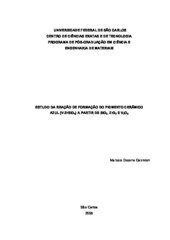Estudo da reação de formação do pigmento cerâmico azul (V-ZrSiO4) a partir de SiO2, ZrO2 e V2O5
Resumen
The present work aimed to study the process of synthesis of one of the most important ceramic pigments manufactured by the traditional method of oxide mixture: the turquoise blue of vanadium doped zircon. The plan proposed to this work was subdivided in four stages with own and complementary objectives to the general objective of the work, which is to identify the role played by the main involved variable in the reaction of synthesis of the pigment in question. Considering that, the reaction of synthesis of blue pigment V-ZrSiO4 consists basically on the synthesis of the ZrSiO4 from SiO2 and ZrO2, Part I studied the effect of the characteristics of raw materials, the method and conditions of mixture and the conditions of calcinations on the reaction of synthesis of zirconium silicate, witch indicated that the mixture method acts in decisive way in the process in solid state of zircon formation. Part II correlated the effect of the amount of inserted doped in crystalline lattice and its influence in the strong color capacity of obtained products, as well as its stability in aggressive glass ways, that showed to the saturation of the crystal host from 7% of used, beyond the slightly harmful influence of the time and temperature of burning in the observed final color. Parts III and IV aimed to study the viability of using the tools of statistical planning of experiment, in the studied of the variable using traditional analysis in part I e II. The results indicated a total correlation between the methodologies, in which the statistical tools generated results with bigger load of information with minimum number of experiments.
